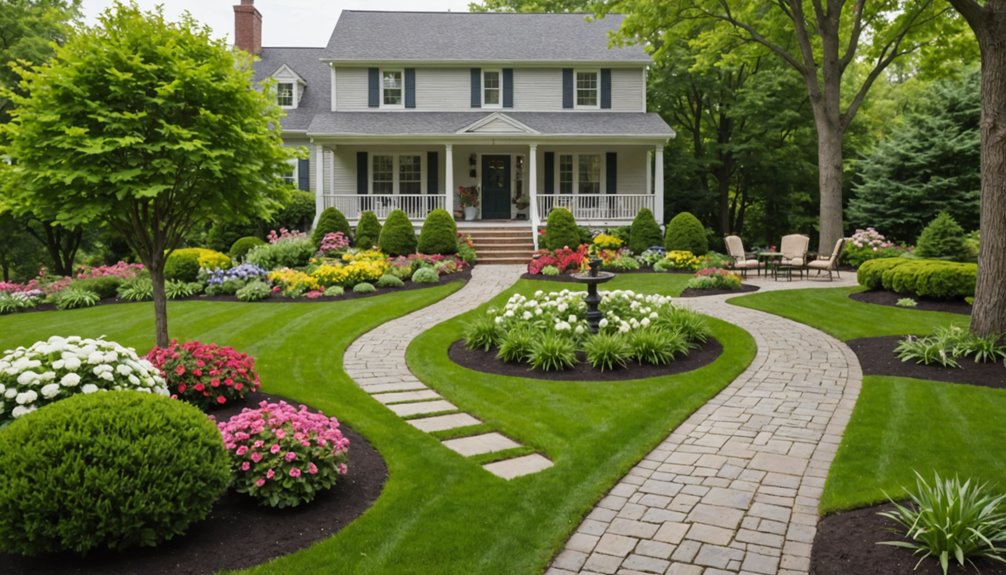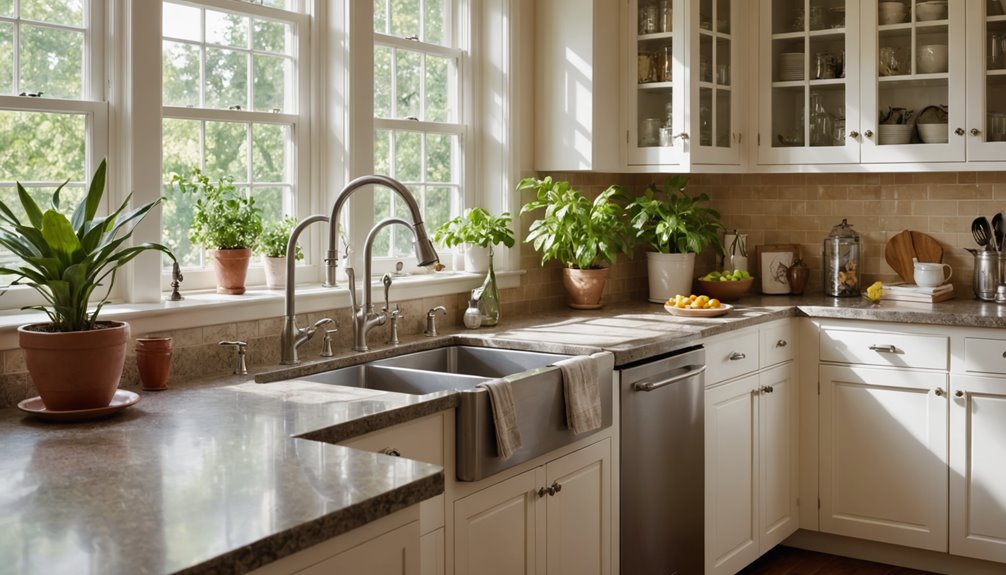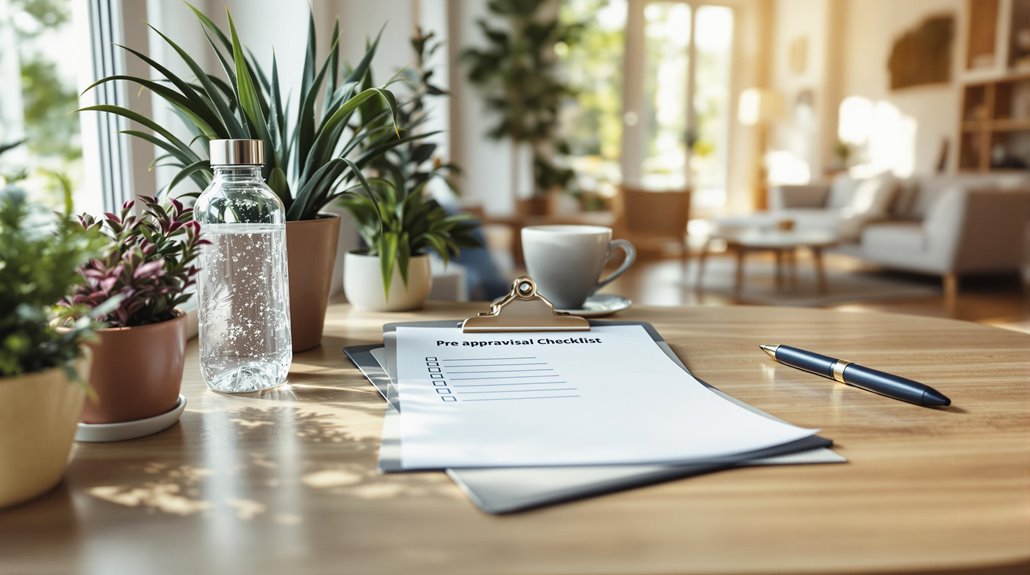A pre-appraisal checklist is a must-have for homeowners who want to get the best valuation for their property. A well-prepared home can increase its appraisal value, sometimes by thousands of dollars. In fact, studies show that improving curb appeal alone can boost home value by up to 7%.
Start with the outside—make sure the roof is in good condition, the foundation is solid, and the landscaping looks neat. Small touches, like a fresh coat of paint on the front door or trimmed hedges, can make a big difference.
Inside, focus on cleanliness and organization. A clutter-free home appears more spacious, which can positively impact the appraiser’s evaluation. Check that all utilities are working correctly, replace burnt-out lightbulbs, and fix minor issues like leaky faucets or squeaky doors.
If there are safety concerns, such as loose railings or faulty smoke detectors, take care of them before the appraisal. A pre-appraisal checklist helps ensure that no important detail is overlooked.
Finally, gather the necessary documents for the appraiser. Have records of any recent renovations, receipts for significant upgrades, and property tax details. For example, if you recently replaced the HVAC system, showing proof can highlight added value.
Appraisers look at every detail, so the more prepared you are, the better your chances of a favorable valuation. With the proper steps, you can maximize your home’s worth and feel confident in the appraisal process!
Key Takeaways
- Ensure all property information, including ownership rights and zoning compliance, is documented and verified for accuracy.
- Conduct a thorough market analysis by comparing recent sales and local economic factors to establish competitive pricing.
- Addressing exterior conditions, such as cleaning, landscaping, and minor repairs, can improve curb appeal and create a welcoming atmosphere.
- Declutter and deep clean the interior, focusing on functionality and neutral decor to enhance overall presentation.
- Perform necessary repairs and safety upgrades, including smoke detectors and handrails, to present a well-maintained property.
Assessing Exterior Condition
A thorough assessment of the exterior condition is critical for identifying potential structural issues and ensuring the property’s integrity. Inspections should begin with the foundation, checking for cracks or settling issues that may indicate deeper problems. Walls must be evaluated for missing or broken siding, mold, and bowing.
The roof’s condition is paramount, requiring checks for missing shingles, leaks, and sagging. Moreover, wall claddings should be inspected for deterioration. Windows and doors must be tested for functionality and integrity, while gutters need examination for blockages. Lastly, flat systems like patios and driveways should be assessed for unevenness.
Conducting regular inspections and maintaining impact-resistant fittings can enhance the property’s longevity and safety. Thorough documentation of these elements aids in tracking necessary repairs, ultimately reinforcing the property’s value and safety for its occupants. Properties showing substantial damage may be rated C6, indicating severe deficiencies that must be addressed.
Enhancing Curb Appeal
Curb appeal serves as the property’s initial impression, greatly influencing potential buyers’ perceptions and general market value. Refurbishing exterior features, such as replacing garage doors and installing durable steel entry doors, improves both functionality and aesthetics. Repairing or repainting shutters and trim contributes positively to the property’s facade, while upgrading house numbers and mailbox designs adds inviting visual warmth.
Additionally, installing concrete paver patios and building outdoor kitchens expand entertaining spaces, thereby increasing livable areas. Incorporating stone veneer and drought-resistant plants supports low-maintenance hardscaping. Ultimately, repainting front doors in bold, neutral hues provides immediate appeal, ensuring the property resonates with prospective buyers and fosters a sense of belonging within the community.
Notably, upgrading your entry door can yield an ROI of up to 118.1%, making it a wise investment. Enhancing curb appeal in neighborhoods with aesthetic appeal can lead to value increases of up to 15%.
Addressing Landscaping Needs

While landscaping often serves as a backdrop to a property’s thorough appeal, its importance in influencing market value cannot be overstated. Regular maintenance of lawns and vegetation, specifically through the strategic placement of healthy front-yard trees, can increase property value by up to 30%. Utilizing native plant species reduces long-term maintenance costs while enhancing visual appeal.
High-quality hardscaping, such as durable decks and well-designed pathways, avoids depreciation issues.
Moreover, incorporating mature plants and sophisticated design elements can yield considerable returns on investment. Conversely, neglecting landscaping needs, such as allowing overgrowth or maintaining blighted vegetation, may risk reducing property value considerably. Consequently, addressing landscaping thoughtfully is vital for maximizing a property’s market potential.
Additionally, poor landscaping can lead to an estimated 10% drop in property value, underscoring the importance of maintaining outdoor aesthetics.
Ensuring that your property aligns with local market trends can significantly enhance its appeal and valuation during appraisals.
Interior Cleaning and Organization
Effective interior cleaning and organization are critical components in preparing a property for appraisal, as they directly impact perceived value and buyer appeal. To optimize the space, it is crucial to declutter surfaces, showcase countertops and tables, and address hidden clutter in cabinets. Organized closets not only demonstrate storage potential but also improve visual appeal.
Surface cleanliness should be prioritized; wiping down kitchen appliances and removing dust from windowsills guarantees a well-maintained environment. Moreover, scrubbing bathroom sinks and eliminating odors contribute to a favorable atmosphere. Maintaining clear walkways facilitates access to critical areas, reinforcing the property’s functionality.
Such meticulous attention to cleaning and organization creates an inviting aura, which is ital for attracting potential buyers and boosting property valuation. Additionally, cleanliness indirectly influences appraisal value, making it essential to present the property in its best light. Furthermore, ensuring a tidy environment aligns with the 28/36 rule by promoting overall financial readiness for potential buyers.
Minor Repairs and Upgrades

A thorough approach to minor repairs and upgrades can significantly improve a property’s appraisal value. Addressing cosmetic repairs, such as interior wall touch-ups and flooring maintenance, enhances aesthetics and guarantees safety. Upgrading exterior paintwork and guaranteeing window and door functionality further boosts curb appeal while preventing drafts.
Critical safety repairs, including installing handrails and functional smoke detectors, should align with compliance standards and mitigate potential appraisal flags. In kitchens and bathrooms, refinishing cabinets and modernizing fixtures not only improve functionality but also raise appeal. Additionally, budgeting for property taxes ensures that potential buyers are aware of ongoing costs, which can enhance their overall perception of value.
Finally, exterior enhancements like landscaping cleanup and roof maintenance reinforce positive initial impressions. Collectively, these strategic improvements create a welcoming environment that resonates with potential buyers and appraisers alike. Additionally, ensuring compliance with minimum property standards is crucial to avoid appraisal surprises and secure financing for buyers.
Preparing Documentation and Records
Preparing documentation and records is a critical step in the appraisal process that guarantees accuracy and compliance. Properly organized documentation improves the credibility of the appraisal and supports informed decision-making. Fundamental categories include client information, property details, and legal compliance.
By ensuring that the assessment reflects theactual value of the property, you enhance the overall appraisal process and align with local market trends that influence property values.
| Documentation Type | Details Required |
|---|---|
| Client Information | Name, address, contractual obligations |
| Property Details | Description, measurements, ownership rights |
| Legal Compliance | Zoning compliance, assessment verification |
| Market Analysis | Comparable sales data, neighborhood consistency |
Thorough verification of ownership rights and market conditions guarantees that the appraisal reflects the actual value of the property. By maintaining accurate records, appraisers can provide reliable assessments that foster trust and belonging in the valuation process.
Final Touches Before the Appraisal

As the appraisal date approaches, taking final touches on the property becomes vital for maximizing its perceived value. This stage involves several fundamental improvements that can significantly impact appraisal outcomes:
- Curb Appeal: Fresh exterior paint, a tidy landscape, and functional house numbers contribute to an inviting initial impression. Enhancing curb appeal can significantly increase the perceived value of your property.
- Interior Presentation: Decluttering, deep cleaning, and minor repairs to walls and fixtures improve the property’s comprehensive appeal. A well-prepared interior not only impresses the appraiser but also reflects the overall condition of the home.
- Safety and Repairs: Addressing structural issues, ensuring utilities are operational, and confirming safety devices function properly demonstrate diligence in property maintenance. This attention to detail is crucial as appraisers thoroughly assess the property’s condition during their evaluation.
Frequently Asked Questions
How Can I Improve My Property’s Energy Efficiency Before the Appraisal?
To improve a property’s energy efficiency before appraisal, one should consider obtaining external certifications, upgrading building systems, engaging qualified appraisers, and ensuring thorough documentation of energy-saving features and compliance with established standards for ideal valuation.
Should I Stage My Home for the Appraisal or Leave It Empty?
In the theater of genuine estate, staging transforms empty stages into inviting homes, enhancing buyer perception. Objective analysis reveals that staged properties often command higher valuations and faster sales, making staging a prudent choice before appraisal.
What Types of Upgrades Provide the Best Return on Investment?
Upgrades such as garage door replacements, kitchen refreshes, and hardwood floor refinishing consistently yield high returns on investment. They enhance both aesthetics and functionality, ultimately increasing property value and buyer appeal in competitive genuine estate markets.
How Long Before the Appraisal Should I Start Preparing?
Preparation for an appraisal should ideally commence 2 to 3 weeks before the assessment, allowing sufficient time for necessary repairs and documentation. This timeframe enables homeowners to strategically improve their property’s appeal and guarantee that all systems function correctly.
Is It Beneficial to Have a Pre-Appraisal Inspection Done?
Ironically, while many homeowners dread inspections, a pre-appraisal inspection can be highly beneficial. It uncovers issues, improves negotiation power, and supports informed pricing, ultimately fostering buyer confidence and expediting the sale process considerably.
Conclusion
A well-prepared home can make a big difference in its appraised value. Studies show that homes with updated features and a clean, well-kept appearance can see a value increase of up to 10%. Using a pre-appraisal checklist helps ensure nothing is overlooked.
Simple updates like repainting walls, deep cleaning carpets, and fixing minor plumbing issues can add to your home’s appeal. These details show appraisers that the property is well cared for, which can positively influence their valuation.
Beyond appearances, having the proper paperwork ready is just as important. Keep records of significant upgrades, such as a new roof or hurricane-impact windows, since these improvements add lasting value. If you’ve recently replaced appliances or upgraded the flooring, providing receipts and warranties can support your home’s worth.
A pre-appraisal checklist keeps everything organized so you can confidently present your home’s best features.
Taking the time to prepare for an appraisal can pay off in a higher home value. If you’re unsure where to start, an experienced local real estate agent can guide you through the process. They know what appraisers look for and can help you focus on improvements that matter most.
With the right approach, you can maximize your home’s worth and feel confident about your property’s valuation.
References
- https://dfritzappraisals.ca/pre-appraisal-checklist-for-homeowners/
- https://www.quickenloans.com/learn/home-appraisal-checklist
- https://better.com/content/maximizing-your-propertys-value-with-a-home-appraisal-checklist
- https://www.manifest.ly/use-cases/realtors/property-appraisal-preparation-checklist
- https://www.homelight.com/blog/home-appraisal-checklist/
- https://selling-guide.fanniemae.com/sel/b4-1.3-06/property-condition-and-quality-construction-improvements
- https://www.easternengineeringgroup.com/everything-you-need-to-know-about-property-condition-assessment/
- https://nwmriskmanagement.com/property-condition-assessment-tips/
- https://www.geoforward.com/property-condition-assessment-report/
- https://nan-amc.com/propertyconditionreport/







